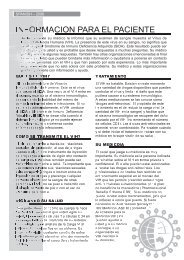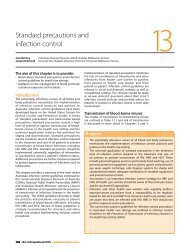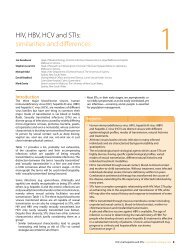B Positive – all you wanted to know about - ASHM
B Positive – all you wanted to know about - ASHM
B Positive – all you wanted to know about - ASHM
You also want an ePaper? Increase the reach of your titles
YUMPU automatically turns print PDFs into web optimized ePapers that Google loves.
Treatment of HCC<br />
tradition<strong>all</strong>y, Hcc has been diagnosed in<br />
advanced stages, when prognosis is uniformly<br />
poor, but with earlier detection, outcomes have<br />
been improving. Predic<strong>to</strong>rs of Hcc prognosis<br />
include: the stage and size of the tumour at<br />
diagnosis; 22 the alpha-fe<strong>to</strong>protein level; 23,24 age;<br />
the presence of liver cirrhosis and the degree<br />
of existing functional reserve; 25 and tumourrelated<br />
fac<strong>to</strong>rs, including size, number and the<br />
degree of tumour spread. 26<br />
therapeutic options for early-stage<br />
disease (where cure is possible) include<br />
surgical resection, liver transplantation and<br />
percutaneous ablation. as no rcts have<br />
compared the relative effectiveness of these<br />
three types of interventions, it remains unclear<br />
which should be the first-line treatment<br />
option for people with early disease. 27 surgical<br />
resection for sm<strong>all</strong> tumours in people with<br />
normal liver function is associated with five-year<br />
survival rates in excess of 50%, 28 but disease<br />
recurrences are common, both loc<strong>all</strong>y and<br />
related <strong>to</strong> new tumour formations in a cirrhotic<br />
liver. 23,29-31<br />
Ortho<strong>to</strong>pic liver transplantation remains the<br />
only option for those with resectable tumours<br />
and decompensated cirrhosis, as it not only<br />
removes the tumour but also the underlying<br />
liver disease. 32 results of earlier surgical series<br />
were fairly poor, but later series demonstrated<br />
that in carefully selected patients, with single<br />
or relatively sm<strong>all</strong> cancers (tumours ≤5 cm in<br />
diameter, or ≤3 tumour nodules, each 3cm<br />
or less in diameter—<strong>know</strong>n as the Milan<br />
criteria) and without vascular invasion, fiveyear<br />
survival rates of 50<strong>–</strong>70% can be achieved,<br />
with low recurrence rates. 30,33 although<br />
HbV infection can be associated with lower<br />
survival rates, combining transplantation with<br />
antiviral therapy achieved a five-year survival<br />
rate in excess of 75%. 34 However, the lack of<br />
available livers for transplantation means that<br />
a significant proportion of those on the waiting<br />
list may end up ultimately being denied<br />
transplantation, due <strong>to</strong> tumour advancement<br />
during the waiting period. 35<br />
Percutaneous ablation of tumours using<br />
chemicals (ethanol or acetic acid) has been<br />
successful in select case series, with best results<br />
achieved with sm<strong>all</strong>, solitary tumours. 36,37<br />
other means of destroying tumour cells<br />
include extreme temperatures, achieved using<br />
techniques such as radiofrequency ablation,<br />
microwaves, laser or cryotherapy. 14<br />
Transcatheter arterial embolisation (TAE)<br />
and transarterial chemoembolisation (tace)<br />
may be indicated in non-surgical patients free<br />
of vascular invasion or extrahepatic tumour<br />
extension. 14 these techniques aim <strong>to</strong> obstruct<br />
the blood supply <strong>to</strong> intermediate-sized tumours<br />
and use an embolising agent (such as gelfoam,<br />
starch microshperes and met<strong>all</strong>ic coils), 38<br />
which in the case of tace is combined with a<br />
chemotherapeutic agent (such as doxorubicin<br />
or cisplatinum). 14<br />
over<strong>all</strong>, systemic chemotherapy for advanced<br />
Hcc has not been very effective, with response<br />
rates below 20% and significant <strong>to</strong>xicity in<br />
cirrhotic patients. 28 targeted therapy using<br />
hepatic artery infusion of chemotherapeutic<br />
agents may prove useful for some patients with<br />
advanced Hcc, 39 but validation in larger trials<br />
is awaited.<br />
Public health approaches for HCC<br />
prevention<br />
the most effective and practical approaches<br />
<strong>to</strong> controlling HbV infection and its longterm<br />
sequelae are primary prevention<br />
approaches, which aim <strong>to</strong> reduce or eliminate<br />
viral transmission. Key interventions include<br />
universal vaccination against HbV, ensuring<br />
a safe blood supply (through screening of <strong>all</strong><br />
blood donations), and harm minimisation<br />
approaches. <strong>to</strong> date, more than 100 countries<br />
have instituted HbV vaccination programs<br />
and there is strong evidence that infant<br />
vaccination is effective in reducing the<br />
incidence of liver cancer and the rate of chronic<br />
infection in children. Within 15 years from<br />
the commencement of mass immunisation<br />
against HbV in taiwan, the rate of chronicity<br />
in children decreased from 9.8% <strong>to</strong> 0.7% 40 and<br />
was par<strong>all</strong>eled by a reduction of the incidence<br />
rate of Hcc in children aged 6<strong>–</strong>14 years. 4<br />
b <strong>Positive</strong> <strong>–</strong> <strong>all</strong> <strong>you</strong> <strong>wanted</strong> <strong>to</strong> <strong>know</strong> <strong>about</strong> hepatitis b: a guide for primary care providers 71






